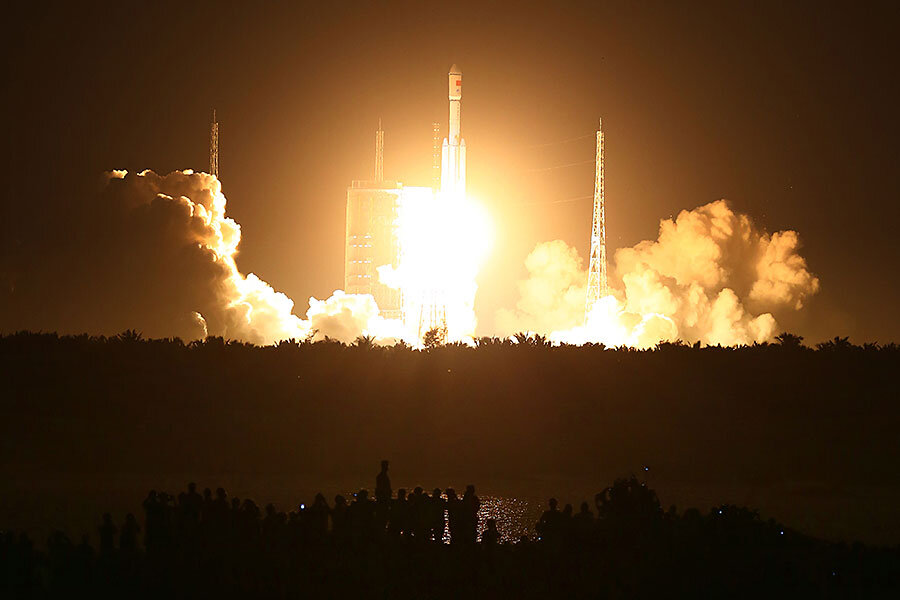Rocket launch success keeps China on track for second space station
Loading...
China launched its most powerful rocket yet as it moves ahead with its plans to establish a permanent space station and to reach Mars in the next decade.
The Long March 7 rocket, capable of lifting about 30,000 pounds into low Earth orbit, carried an unmanned, experimental probe Saturday, which landed on the Inner Mongolian steppe. The Long March 7 did so with a more sustainable, powerful fuel. An accomplishment in itself, the success of the Long March 7 will be eclipsed later this year by the heavy-lift Long March 5, which will be able to carry up to 55,000 pounds, according to Spaceflight Now.
China plans to have more than 200 spacecraft in orbit by 2020 and to perform an average of 30 launches per year. China's pride in its space program is a reflection of the country's “rising global stature and mounting technical expertise, as well as evidence of the ruling Communist party’s success in transforming the once poverty-stricken nation,” notes The Guardian.
Regardless of its personal motivations to explore the far reaches of the universe, China’s space program, as well as other Asian countries, have extended beyond just replicating the accomplishments of the Americans and Russians. Countries like China and India are improving space travel.
The Long March 7 is just one example. The more sustainable, powerful fuel it used, for instance, is composed of a mix of kerosene and liquid oxygen, rather than the more toxic hypergolic propellants China used in its previous rockets. The Long March 7 was launched closer to the equator as well, requiring less propellant, and saving the country roughly $6 million each time it blasts off, according to The Verge.
The Long March 5 China is expected to test later this year will be its largest carrier rocket. It is expected to carry the lunar probe Change’e 5, named for the mythological goddess of the moon, and the core module for China’s space station and Mars probe, according to the Chinese-government-run Xinhua News Agency.
China has invested more than a billion dollars into its space program, and has racked up a series of accomplishments. It launched its first manned flight in 2003 and conducted its first spacewalk in 2008. It's first space lab, Tiangong 1, a precursor to a planned permanent space station, launched into orbit in 2011. It's moon rover, Yutu, landed in 2014. China also plans to be the first to explore the far side of the moon, in 2018, and to send a rover to Mars, around 2020.
The mission to the far side of the moon, in particular, is a departure from previous Chinese missions, which have replicated accomplishments of the Americans and Russians, as reported by The Christian Science Monitor’s Jason Thomson.
As China has becomes a space pioneer, it has collaborated with India, Russia, and the European Space Agency, Clive Neal, professor of geology at the University of Notre Dame and chair of the Lunar Exploration Analysis Group, told Mr. Thomson in an interview. However, US law prevents NASA from collaborating with the Chinese, according to Dr. Neal.
Although China maintains that its space program is peaceful, that it is operated by its military is cause for concern, at least for some Americans.
“China’s rise as a space power has important national security implications for the United States, which relies on its own space capabilities to assess and monitor current and emerging threats to national security and project military power globally,” reads the 2015 Report to Congress of the China-US Economic and Security Review Commission. “China’s aspirations are driven by its assessment that space power enables the country’s military modernization and would allow it to challenge US information superiority during a conflict.”
Even so, China and India are pushing the boundaries of space travel. India was the first Asian country to reach Mars, doing so with $75 million, compared with the NASA Maven, which cost the American space agency $670 million to enter the orbit of the Red Planet at the same time as India’s Mangalyaan Hindi, as the Monitor's Simone McCarthy reported earlier this month.
India has also seen success with its miniature reusable rocket. Privately-owned space companies have also tested reusable rockets. Blue Origin has completed four such successful launches and landings with suborbital rockets, and SpaceX's has had four successful landings from orbital speeds, with a fifth scheduled the fall.
[Editor's note: An earlier version misstated the number of successful landings SpaceX has completed.]
This report contains material from the Associated Press.





